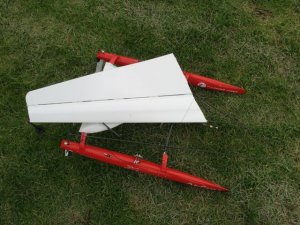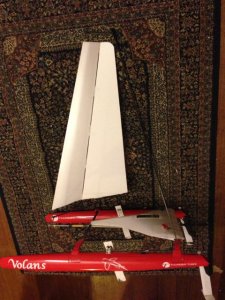Something a little different. I've recently made a couple of mast aft wing sails, one for a small trimaran and another for an RG65. Having made these it occurred to me that this type of sail might be particularly suited to a catamaran. To test this idea I've put a fairly rough boat together (the hulls are the floats of a Volans trimaran):



The mast aft sail is clearly not new and has been used on rc boats previously. One advantage of this type of sail is that it should reduce pitch poling as the sail produces an upward rather than downward force. This was the main attraction for trying it out on a catamaran. There is also an advantage of using a solid sail. A problem for soft mast aft sails is that it is difficult to stop the boom from lifting and spoiling the shape of the sail, fortunately this isn't a problem for a solid wing. The other new feature of this set up is the use of two lightweight masts and consequently only one stay. This type of sail puts a lot of tension on the mast and hull, using two masts on a catamaran this force is spread over a larger part of the boat. An added benefit of the design is that it is easily dismantled.
Here is a short video of my first attempt:
The boat needs quite a bit of work. It suffers from excessive lee helm, it doesn't yet sail very close to the wind and the rudder setup isn't ideal, however, it looks promising. In fairly strong winds it didn't pitch pole. With these hulls I've tested more conventional wing sails and had significant problems with pitch poling.
The boat is currently dismantled and undergoing modifications. Any suggestions would be appreciated.



The mast aft sail is clearly not new and has been used on rc boats previously. One advantage of this type of sail is that it should reduce pitch poling as the sail produces an upward rather than downward force. This was the main attraction for trying it out on a catamaran. There is also an advantage of using a solid sail. A problem for soft mast aft sails is that it is difficult to stop the boom from lifting and spoiling the shape of the sail, fortunately this isn't a problem for a solid wing. The other new feature of this set up is the use of two lightweight masts and consequently only one stay. This type of sail puts a lot of tension on the mast and hull, using two masts on a catamaran this force is spread over a larger part of the boat. An added benefit of the design is that it is easily dismantled.
Here is a short video of my first attempt:
The boat needs quite a bit of work. It suffers from excessive lee helm, it doesn't yet sail very close to the wind and the rudder setup isn't ideal, however, it looks promising. In fairly strong winds it didn't pitch pole. With these hulls I've tested more conventional wing sails and had significant problems with pitch poling.
The boat is currently dismantled and undergoing modifications. Any suggestions would be appreciated.

 .
.